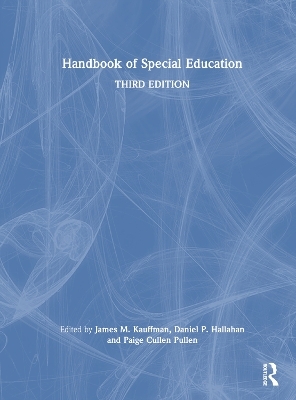
Handbook of Special Education
Routledge (Verlag)
978-1-032-29928-0 (ISBN)
- Noch nicht erschienen (ca. Mai 2026)
- Versandkostenfrei innerhalb Deutschlands
- Auch auf Rechnung
- Verfügbarkeit in der Filiale vor Ort prüfen
- Artikel merken
This book provides comprehensive coverage of all aspects of special education in the United States including cultural and international comparisons. The Handbook of Special Education discusses emerging trends in the field for researchers and practitioners while also providing foundational material for graduate students and scholars. The third edition has been updated and shortened to make it more accessible and helpful to all of its users, taking into account the recent developments and most current academic research in the field.
James M. Kauffman (Ed.D., University of Kansas) is Professor Emeritus of Education at the University of Virginia, where was a faculty member from 1970—2006. He received the Research Award from the Council for Exceptional Children in 1994 and the Outstanding Leadership Award from the Council for Children with Behavioral Disorders (of which he is a past president) in 2002. Daniel P. Hallahan (Ph.D., University of Michigan) is Professor Emeritus of Education at the University of Virginia, where he had been a faculty member in the Curry School of Education since 1971. He is a past president of the Division for Learning Disabilities of CEC and in 2000 received the CEC Career Research Award. Paige Cullen Pullen (Ph.D., University of Florida) is Professor of Special Education at the University of Florida and the Chief Academic Officer at the Lastinger Center for Learning. She has been principal investigator on federally funded projects, co-authored books, book chapters, and articles on evidence-based reading instruction.
Section I. Historical and Contemporary Issues 1. Nature, History, and Prospects 2. Multi-Tiered Systems of Support as Special Education Reform: A Critical Appraisal 3. What Do We Know About Effective Teaching and Teacher Education for Teachers Working with Students with Disabilities? 4. Purpose and Ethics of Special Education Section II. Statistical Concepts and Research Methods 5. Statistics, Data, and Special Educational Decisions: Basic Links to Realities 6. Single-Case Experimental Design 7. Issues and Considerations for Research Integrity in Special Education 8. Systematic Literature Reviews and Meta-Analyses in Special Education Section III. Legal Aspects 9. The Individuals with Disability Education Act: A Historical Review 10. The Individuals with Disabilities Education Act: School District’s Obligations Under the Law Section IV. The General Education Context 11. Academic Progress Monitoring 12. Necessary Differences Between General and Special Education Section V. Special Education Categories 13. Intellectual and Developmental Disabilities 14. Specific Learning Disabilities 15. Emotional and Behavioral Disorders 16. Severe and Multiple Disabilities 17. Communication Disorders 18. Deaf and Hard of Hearing Students 20. Traumatic Brain Injury 21. Autism Spectrum Disorder: Understanding Current Educational Research and Practice 22. Special Gifts and Talents Section VI. Policy, Leadership, and Administration 23. Conceptual Models of Special Education: Implications for Improving Instruction for Students with Disabilities 24. Public Funding for Special Education 25. Factors Shaping the Special Education Teacher Workforce 26. Challenges Facing the Special Education Teacher Workforce: Composition, Distribution, and Effectiveness 27. Using Implementation Frameworks to Guide the Preparation of Leaders and Administrators of Special Education Section VII. Instruction 28. Effective Reading Instruction 29. Writing Instruction for Students with Disabilities 30. Improving Arithmetic, Word-Problem, and Fractions Performance in Students with Mathematics Learning Disabilities 31. Science and Social Studies 32. Physical Education: A Federally Guaranteed Component of Special Education 33. Teaching Behavior and Emotion 34. No Longer a Niche on the Fringe: Technology’s Front and Center Role in Special Education Section VIII. Transition 35. Transition from School to Work of Individuals with Disabilities 36. Transition to Postsecondary Education 37. Transition to Independent Living Section IX. Parent and Family Issues 38. Building and Maintaining Trusting and Equitable Partnerships with Families 39. P Partnering with Family Members to Support Children’s Development Section X. Early Identification 40. Principles and Practices of High-Quality Early Intervention Part C Services 41. Evidence-Based Practices of Early Childhood Special Education Section XI. Cultural and International Issues 42. International teacher issues in special and inclusive education 43. International Special Education: The Influence of the CRPD in European Countries and Beyond
| Erscheint lt. Verlag | 25.5.2026 |
|---|---|
| Zusatzinfo | 31 Tables, black and white; 16 Line drawings, black and white; 16 Illustrations, black and white |
| Verlagsort | London |
| Sprache | englisch |
| Maße | 210 x 280 mm |
| Gewicht | 1970 g |
| Themenwelt | Sozialwissenschaften ► Pädagogik ► Allgemeines / Lexika |
| Sozialwissenschaften ► Pädagogik ► Bildungstheorie | |
| Sozialwissenschaften ► Pädagogik ► Sonder-, Heil- und Förderpädagogik | |
| Sozialwissenschaften ► Politik / Verwaltung | |
| Sozialwissenschaften ► Soziologie ► Makrosoziologie | |
| ISBN-10 | 1-032-29928-2 / 1032299282 |
| ISBN-13 | 978-1-032-29928-0 / 9781032299280 |
| Zustand | Neuware |
| Informationen gemäß Produktsicherheitsverordnung (GPSR) | |
| Haben Sie eine Frage zum Produkt? |
aus dem Bereich


